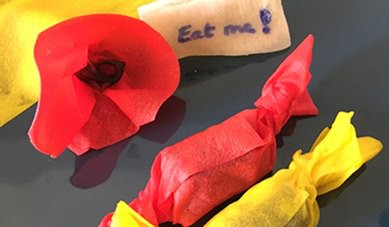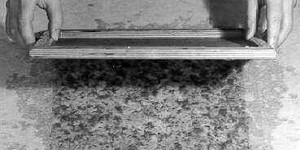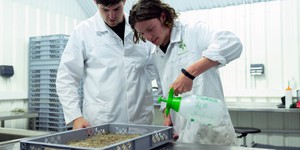Homemade Rice Paper
Summary
Introduction
Have you ever encountered "paper" on your plate—perhaps in the form of thin paper for spring rolls, or cake decorating? Did it make you wonder how this paper relates to the paper you write on? You will find out in this activity! In addition, you can discover the recipe to make the edible paper you like best.
Materials
- Brown rice flour
- Potato starch
- Water
- Small bowl
- Tablespoon
- Spoon
- Microwavable plate
- Plastic Wrap
- Microwave
- Sheet of paper
- Pencil or pen
- Optional: Salt
- Optional: Food-color (edible ink) pen
- Optional: Zip-top bag
- Optional: Adult help
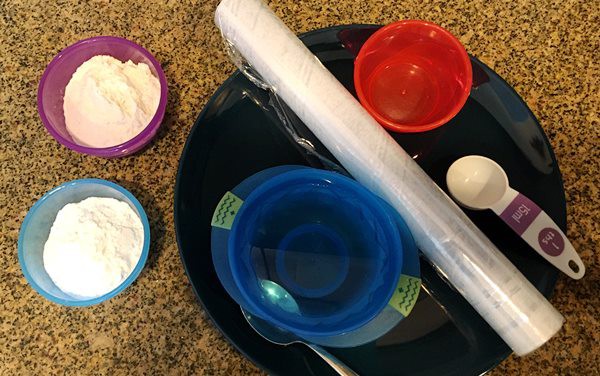 Image Credit: Sabine De Brabandere, Science Buddies / Science Buddies
Image Credit: Sabine De Brabandere, Science Buddies / Science Buddies
Prep Work
- Stretch plastic wrap tightly over the microwavable plate so that it clings to the sides and does not touch the center of the plate.
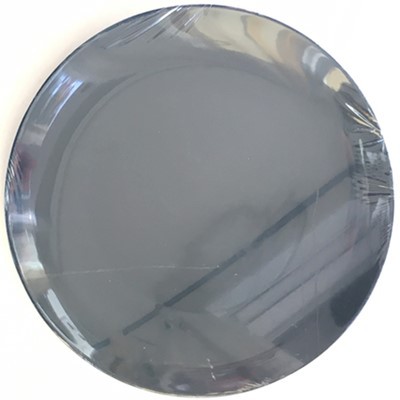 Image Credit: Sabine De Brabandere, Science Buddies / Science Buddies
Image Credit: Sabine De Brabandere, Science Buddies / Science Buddies
- To the small bowl, add one tbsp. of rice flour, one tbsp of potato starch, and about 1.5 tbsp. of water, as well as, optionally, a pinch of salt—this is Recipe 1. Mix the ingredients until you have a smooth paste. The paste should have the consistency of white school glue. Add a little additional water if the paste is too stiff.
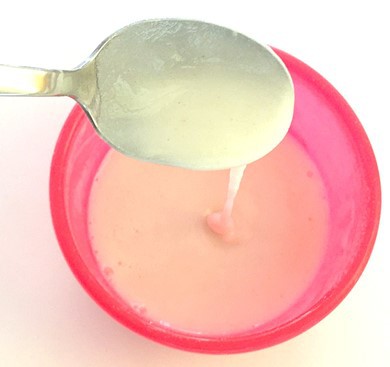 Image Credit: Sabine De Brabandere, Science Buddies / Science Buddies
Image Credit: Sabine De Brabandere, Science Buddies / Science Buddies
- Pour the paste onto the plastic wrap. Spread the paste out evenly with a spoon and/or by tilting the plate.
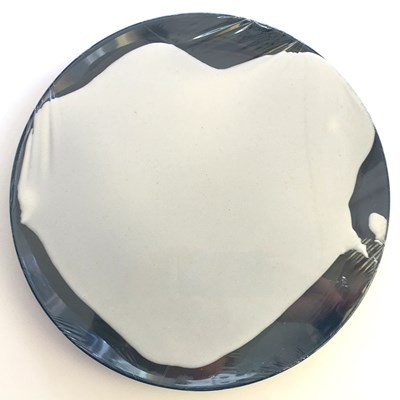 Image Credit: Sabine De Brabandere, Science Buddies / Science Buddies
Image Credit: Sabine De Brabandere, Science Buddies / Science Buddies
- Put the plate in the microwave, and heat the paste on high for about 45 seconds to dry it. (Note that the exact duration depends on your microwave.) The sheet of paper will look dry when it is done. (Safety note: In general, food should not touch plastic wrap while it is being heated in a microwave, but it is fine occasionally for items of which you eat relative small quantities.)
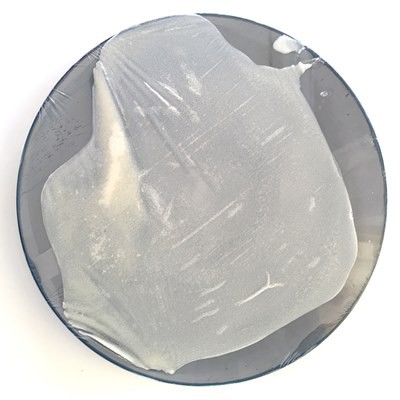 Image Credit: Sabine De Brabandere, Science Buddies / Science Buddies
Image Credit: Sabine De Brabandere, Science Buddies / Science Buddies
- Let the sheet of paper cool. The edges might curl up a bit while cooling.
- Remove the sheet of paper from the plastic wrap. This can be tricky so take your time! Removing the plastic wrap from the plate first might help. Turning over the plate with plastic wrap and paper is another strategy. You could also ask an adult to help with this step.
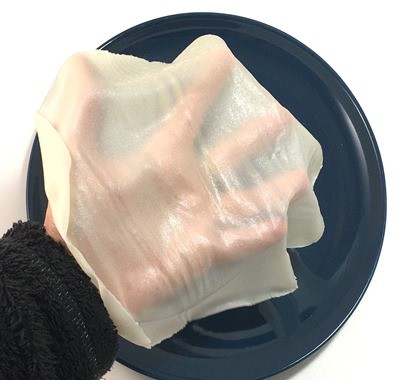 Image Credit: Sabine De Brabandere, Science Buddies / Science Buddies
Image Credit: Sabine De Brabandere, Science Buddies / Science Buddies
- Lay your finished sheet on a plate.
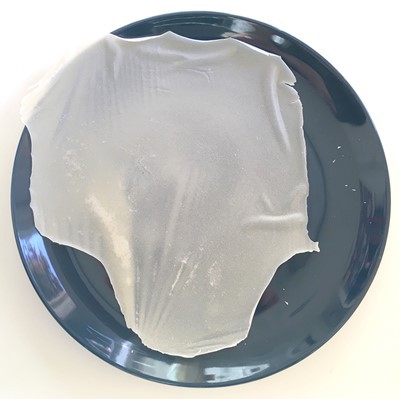 Image Credit: Sabine De Brabandere, Science Buddies / Science Buddies
Image Credit: Sabine De Brabandere, Science Buddies / Science Buddies
- Repeat the paper making procedure two more time so. This time aim to produce sheets that are as thin as you can make them. It is ok if some break in the process. A small piece to test is enough for the activity, and you will get better with practice. (If you need to take a break, store the sheets of paper in a zip-top bag so they do not dry out.)
- Divide your sheet of paper into two columns. Leave the first blank, write "Recipe 1" at the top of the second.
- Create at least eight rows in your table. In the first column of the table, label the first one "easy to make," the second one "appearance," the third one "smoothness," the fourth one "flexibility," the fifth one "strength," the sixth one "stretchiness," the seventh one "taste" and the eighth one "total."
Instructions
- Now it is time to test the sheets of edible paper! As you observe your paper, see if you can attribute the qualities to the ingredients used. Rice flour contains cellulose fiber, the thread-like part you find in plant material. The potato starch contains no fiber but does contain starch, which can act to provide strength and resiliency.
- Evaluate how easy it was to make the sheets. Mark an "X" in the box if you felt it was easy to make.
- Observe the appearance of the sheets. Mark an "X" in the box if you feel the sheets look appealing.Do you think sheets made with only rice flour or only starch would look better? If so, why do you think so?
- Feel the smoothness of the surface of the sheets. Mark an "X" in the box if you feel the surface is smooth.Do you think sheets made with only rice flour or only starch would feel smoother? If so, why do you think so?
- Bend your paper as if you were going to roll it. Place an "X" in the corresponding box if you feel your paper is flexible.
- Try to create a small rip in the sheets. Place an "X" in the box if you feel the paper is strong.Do you think sheets made with only rice flour or only starch would be stronger? If so, why do you think so?
- Try to stretch a sheet. Place an "X" in the corresponding box if the paper is stiff.Do you think sheets made with only rice flour or only starch would be stiffer?
- Have a taste. Place an "X" in the corresponding box if you feel the paper that has a nice taste and mouth feel.Do you think sheets made with only rice flour or only starch would taste better or have a more pleasant feeling in your mouth? If so, why do you think so?
- Tally the Xs for your recipe, and write the total in the eighth row.
- Think of what you like to use the paper for: spring rolls, cake decoration, candy wrappers, etc.What criteria does your paper need? Did you test all these criteria?
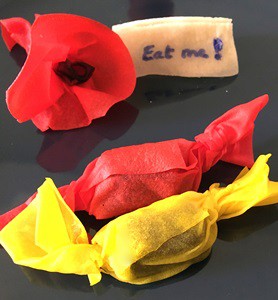 Image Credit: Sabine De Brabandere, Science Buddies / Science Buddies
Image Credit: Sabine De Brabandere, Science Buddies / Science Buddies
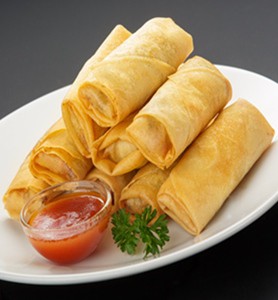 Image Credit: Sabine De Brabandere, Science Buddies / Science Buddies
Image Credit: Sabine De Brabandere, Science Buddies / Science Buddies
- If you like to test more criteria, write them out in your table, and test them.
- Start experimenting!Can you change the recipe and create one that is better than the best result you obtained with this recipe?
What Happened?
Did your edible paper fulfill most of the characteristics you tested?
Rice flour contains insoluble fibers called cellulose. These fibers make the sheets made of pure rice flour flexible, non-stretchy and strong, characteristics we associate with sheets of paper. It also makes for a rougher surface and feeling in the mouth.
Potato starch contains no fiber. Sheets made from pure starches are flexible and smooth but stretchy. It is also difficult to make a thin sheet with a paste made of only starches and water. These sheets do not show the characteristics we associate with paper because they do not contain insoluble fiber.
The combination of the insoluble fibers from rice and the starches from potato starch as in the recipe used in this activity can create the desired outcome: a smooth surface on a strong, flexible, non-stretchy sheet. The reduced amount of fibers also provides a smoother feel in the mouth.
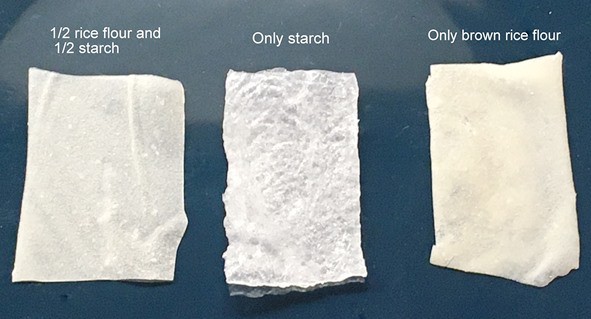 Image Credit: Sabine De Brabandere, Science Buddies / Science Buddies
Image Credit: Sabine De Brabandere, Science Buddies / Science Buddies
Digging Deeper
Paper is made up of plant fibers pressed together into a thin, flexible-but-strong mat. The fibers are from a material called cellulose, which gives plants their structural support. Cellulose is the thread-like component in grains, greens and other vegetables or fruits. It is also found in other plants as well. Wood also has a lot of cellulose; in fact, approximately 50 percent of the matter in wood is cellulose. Brown rice flour by comparison contains about 2 percent cellulose.
Cellulose has many qualities that make it an excellent material for creating paper. If it is soaked and then dried, it becomes a flexible, strong material. Evaluate an unwrinkled sheet of paper—which is essentially a mat of cellulose. How smooth is it? Can it be stretched? To test its flexibility, try rolling it into a tube. To evaluate its strength, try gently tearing a corner. Observe how much resistance the paper provides.
To make commercial paper strong, manufacturers also add starches. Starches are sugars found in plants. When heated with a liquid, starches absorb the liquid, expand, and form a network of starch particles. This makes starches handy as a gluing and stiffening agent for paper.
Cellulose and starch are both edible, so homemade paper can be, too. (Of course, you wouldn't want to eat notebook or other store-bought paper because it is made with other chemicals.)
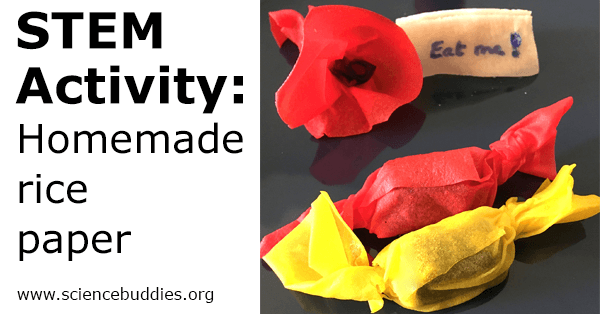 Image Credit: Science Buddies
Image Credit: Science Buddies
Ask an Expert
For Further Exploration
- Think of different uses for paper—from writing to origami to food uses. What sorts of qualities are most important for each of those uses? Can you create a recipe that performs best for a specialized use?
- Use a food-color pen to write on the papers or color the paper with food coloring. Does the "ink" bleed? Can you find a recipe that is optimal for making edible paper to write on?
- Replace the ingredients with others that have a similar fiber content. For example, replace the potato starch with cornstarch or tapioca and/or the rice flour with wheat flour. How does a change of one ingredient change the paper's characteristics ? Can you explain why this might happen?
Related Resources
Project Ideas
Activities
Links
- Blog Post: Stretchy Dough and the Science of Gluten
- Scientific American: Recycle! Make Old Paper New
- Some Interesting Facts: How Is Paper Made Step By Step


